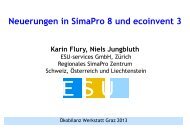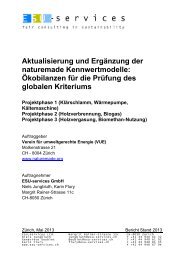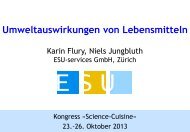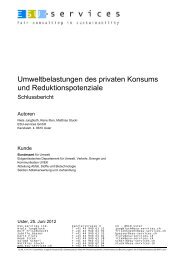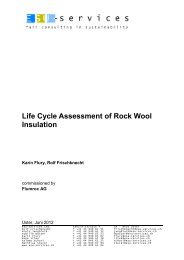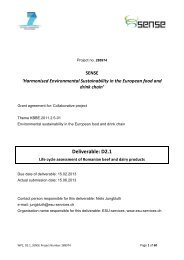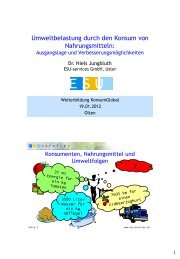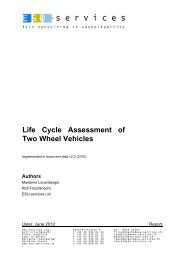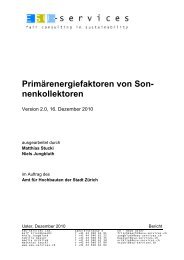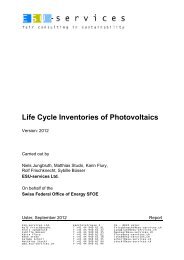Life-Cycle-Assessment for Stoves and Ovens - ESU-services Ltd.
Life-Cycle-Assessment for Stoves and Ovens - ESU-services Ltd.
Life-Cycle-Assessment for Stoves and Ovens - ESU-services Ltd.
You also want an ePaper? Increase the reach of your titles
YUMPU automatically turns print PDFs into web optimized ePapers that Google loves.
the damage level defined <strong>for</strong> it. Much work has been carried out particularly by the Dutch<br />
National Institute <strong>for</strong> Public Health <strong>and</strong> Environmental Hygiene(RIVM) in this field. Detailed<br />
maps of Europe are now available in which the environmental problems are shown in<br />
a high degree of detail. These data were used to determine the current level of an environmental<br />
problem <strong>and</strong> by what factor the problem must be reduced to reach an acceptable<br />
level. A table lists the weighting factors <strong>and</strong> the criteria applied.<br />
This table reveals that high priority must be given to limiting substances causing ozone<br />
layer damage <strong>and</strong> the use of pesticides. The latter is becoming a very serious problem in the<br />
Netherl<strong>and</strong>s in particular. Furthermore, a great deal of consideration must be given to the<br />
diffusion of acidifying <strong>and</strong> carcinogenic substances. It is apparent from the table that a<br />
number of effects that are generally regarded as environmental problems have not been included.<br />
The reason <strong>for</strong> omission of a number of effects is given below:<br />
Toxic substances that are only a problem in the workplace Many substances are only<br />
harmful if they occur above a certain concentration. Such harmful concentrations can occur<br />
relatively easily in the workplace, while the concentration outside often remains very low<br />
<strong>and</strong> well below the damage threshold. This happens because the substances are generally diluted<br />
to a large extent <strong>and</strong> because many substances disappear from the atmosphere because<br />
of natural decomposition processes. Only substances that actually are found in harmfull<br />
concentrations are included in the Eco-indicator, while the rest are disregarded. This means<br />
that a product with a low Eco-indicator score can still cause poor working conditions because<br />
substances are released that are harmful locally.<br />
Exhaustion (depletion) of raw materials If a product made of very rare raw materials is<br />
used this rarity is not expressed in the indicator; after all, the fact that a substance is rare<br />
doesnot cause any damage to health. The emissions arising from extraction of the raw materials<br />
are included <strong>and</strong> are usually extensive because ever lower-grade ores have to be used.<br />
Incidentally, the term „exhaustion“ is very difficult to define. Alternatives are available <strong>for</strong><br />
most raw materials, <strong>and</strong> recycling could enable raw materials to remain in circulation <strong>for</strong><br />
much longer. In fact minerals never disappear from the Earth; at worst they are diffused in<br />
an un<strong>for</strong>tunate manner.<br />
Waste The fact that waste occupies space is not particularly important in environmental<br />
terms because the amount of ecosystem lost to the mountains of waste is relatively small<br />
compared with the damage to ecosystems caused, <strong>for</strong> example, by acidification. However,<br />
the substances released by waste (heavy metals, or CO2 on incineration) are very important.<br />
These latter effects are included in the indicator, but the quantity of waste in itself is not<br />
part of the assessment process.<br />
As a result of these differences the Eco-indicator can be seen as an indicator of emissions,<br />
<strong>and</strong> raw materials depletion <strong>and</strong> the use of space by waste must be evaluated separately at<br />
present.<br />
Annex<br />
- 32 -<br />
6.1.5 Conclusion<br />
The Eco-indicator is primarily a tool <strong>for</strong> the designer. It allows the designer to make its own<br />
LCA´s with the help of 100 pre-defined LCA´s <strong>for</strong> commonly used materials <strong>and</strong> processes.<br />
The designer can use the Eco-indicator in two ways:<br />
• To get the questions right (what are the primary causes of the environmental burden of a<br />
product)<br />
• To get the answers right (which design alternative has the lowest environmental burden)<br />
The methodology is an extension of the SETAC LCA methodology, it uses a Normalisation<br />
<strong>and</strong> an evaluation stage. The evaluation is based on the best available knowledge of the environmental<br />
damage of effects on an European scale.<br />
6.1.6 Bibliography<br />
1. Ahbe S. et al. Methodik für Oekobilanzen (Method <strong>for</strong> Environmental <strong>Life</strong> <strong>Cycle</strong><br />
<strong>Assessment</strong>s), Buwal, publication 133, October 1990, Bern,Switzerl<strong>and</strong>. This report<br />
(in German) describes the development of the Swiss Ecopoints weighting method.<br />
2. Goedkoop M.J.; Demmers M.; Collignon M.X.; The Eco-indicator 95, Manual <strong>for</strong><br />
designers; NOH report 9524; PRé consultants; Amersfoort(NL); juli 1995; ISBN<br />
90-72130-78-2. This report describes the application of the Eco-indicators by designers.<br />
It does not require anyknowledge on LCA’s.<br />
3. Goedkoop M.J.; The Eco-indicator 95, Final report (in English); NOH report 9523;<br />
PRé Consultants; Amersfoort (NL); juli 1995; ISBN90-72130-80-4. This report describes<br />
the methodology used. It does require some knowledge on LCA’s.<br />
4. Goedkoop M.J.; Cnubben P; De Eco-indicator 95, bijlage rapport (annexe report);<br />
NOH report 9514 A; PRé Consultants; Amersfoort (NL);juli 1995, ISBN 90-72130-<br />
76-6 (only available in Dutch). 5<br />
5. Heijungs R. (final editor) et al; Environmental life cycle assessment of products,<br />
Guide <strong>and</strong> Backgrounds, NOH report 9266 <strong>and</strong> 9267; Leiden;1992; commissioned<br />
by the National Reuse of Waste Research Programme (NOH), in collaboration with<br />
CML, TNO <strong>and</strong> B&G. This is thewidely used guide <strong>for</strong> LCA practicioners.<br />
6. RIVM, The environment in Europe: A global perspective, Sept. 1992, ISBN 90-<br />
6960-031-5. This report describes most of the environmentaldamage caused by environmental<br />
effects.<br />
7. SETAC, Society of Environmental Toxicology <strong>and</strong> Chemistry, Guidelines <strong>for</strong> <strong>Life</strong>-<br />
<strong>Cycle</strong> <strong>Assessment</strong>, a ‘Code of Practice’, Brussels, Belgium,1993. This is a general<br />
description of the basic principles of LCA



